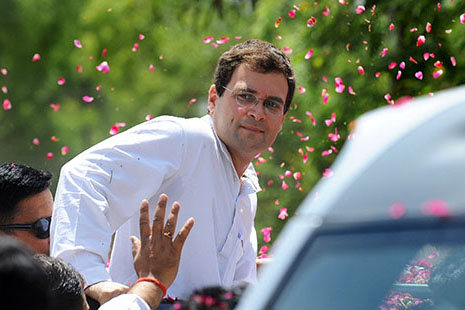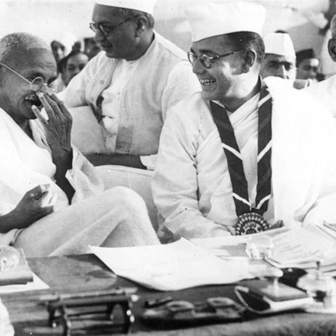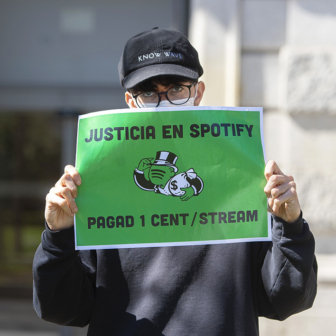THERE PROBABLY aren’t too many eighty-one year olds who have an iPhone and their own blog. Lal Krishna Advani does. He can also put his name to a number of websites, a Facebook group and over 250 YouTube clips. But Advani’s subscription to cyberspace shouldn’t come as a surprise. As prime ministerial candidate for the Hindu nationalist Bharatiya Janata Party, or BJP, in India’s upcoming national elections, he is one of scores of political candidates who are using blogs, text messaging, video platforms and social networking sites to reach out to Indian voters. Welcome to e-campaigning in these, the largest and most plugged-in elections in democratic history. And meet the target constituency: India’s colossal youth electorate.
In a nation where a quarter of eligible voters are now between the ages of eighteen and twenty-five, the 2009 elections will see a potential 100 million young Indians heading to the polls for the first time between 16 April and 13 May. This isn’t any old India, as PepsiCo’s recent series of TV commercials suggests, this is “Youngistaan,” the Land of the Young. And just as the demographic reality of India’s youth bulge hasn’t passed soft drinks corporations by, neither has it escaped the attention of India’s political hopefuls. In the run-up to the elections, national and regional parties alike have been anxiously reworking their campaign strategies to appeal to youth – or what the media now chummily refers to as Young India.
At the heart of this drive is Obama-inspired online campaigning. Stirred by the Democrats’ success in the United States, India’s major parties have been eagerly integrating the internet into their election drives. The BJP, leading party of the National Democratic Alliance, one of two coalitions competing for power, commands the biggest political web presence in the country. It has also seen fit to advertise on more than 3000 websites and target some half million subscribers with a daily email dispatch.
Equally keen to make waves on the web has been the BJP’s major rival, the Congress Party, which heads the ruling coalition, the United Progressive Alliance. Its party website offers a downloadable ringtone of Jai Ho, the signature tune to the award-winning film Slumdog Millionaire. The unmistakable anthem – whose title roughly means “victory” in Hindi – won homegrown composer A. R. Rahman an Academy Award and widespread reverence from the Indian public in February. Quick to cash in on the film’s popularity with young voters, Congress acquired rights to the song and rejigged the lyrics to harmonise with its campaign.
In a more modest fashion, regional parties such as the Telegu Desam Party and the Bahujan Samaj Party – whose leader, Mayawati, the Dalit chief minister of Uttar Pradesh, could rustle up a “third front” of left-wing and regional parties to challenge the United Progressive Alliance and the National Democratic Alliance – have also launched websites to cater to the young and tech-savvy among their constituencies.
One of the biggest challenges facing Indian parties is the very real task of getting these new voters out to the polls. While turnout in the eighteen to twenty-four age group was higher than 50 per cent at the last four national elections, it was persistently lower than that of older voters. There were also stark differences in turnout patterns across the rural–urban divide. According to Sangeeta Talwar, only 10 per cent of urban youth voted in the last elections. Her company, Tata Tea, has backed a young team from the Bangalore-based NGO, Janaagraha, in their Jaago Re! (“Hey, wake up!”) campaign, a non-partisan “enabling platform” aimed at demystifying the political process and encouraging voter registration. The Jaago Re! web interface is chatty and user-friendly, urging visitors to get themselves onto the electoral roll. Yet for all its inclusiveness, the website’s entire content – except its Hindi slogan – is in English, a language which remains the preserve of a minority in India, and has limited hope of reaching out to a broad group of young people. As the Delhi-based online research company JuxtConsult revealed recently, only 13 per cent of internet users in India prefer to read online content in English.
From the online offerings of the so-called “national” parties it would be hard to deduce that India is home to an estimated 415 languages, twenty-two of which are classified “official.” While Lal Krishna Advani’s website tracks a campaign trail that criss-crosses linguistic boundaries, the details are only available in English and Hindi. Although a widely spoken language, Hindi is the primary tongue of only 41 per cent of the population. The Congress website is only marginally more inclusive, offering web content in Urdu, too. As a language associated with India’s 13.4 per cent Muslim population, its inclusion underscores the party’s secular identity.
Language issues aside, it’s difficult to get a sense of just how many Indians use the internet. The BJP’s IT cell puts the number at a staggering 250 million, which may explain the party’s enthusiasm for web-based campaigning. But more conservative estimates, like the one from JuxtConsult of forty-seven million in January 2009, paint a less optimistic picture of the effectiveness of cyber-shortcuts. Estimates see the influence of the internet on election results as limited to about fifty seats out of an available 543. The reality is that most of India’s voters live in rural areas where internet access is limited or non-existent.
Reaching out to the electorate with Advani’s iPhone might be a better bet. In the state of Gujarat, the BJP has created a database of 25,000 mobile numbers which it targets with bulk messaging. Mobile phone technology is more widely used in rural India than the internet: at the start of 2009, the total number of wireless telephones connections stood at over 360 million, according to the Telecom Regulatory Authority of India. While well over two thirds of India’s population live in the countryside, only 9 percent of rural Indians own a phone, compared to 66 percent of city dwellers. Tagged the “next accelerator” for mobile growth, the rural market is the new target of telecoms companies, who are working together to bring infrastructure to remote areas quickly and cheaply.
The pervasiveness of the mobile phone – at least in the Indian imagination, if not yet in the shirt pocket or sari fold – makes the concept of political participation via telecommunication devices more this-worldly than one might think. The latest TV commercial from Idea Cellular, a mobile service operator with a pan-Indian customer base of 36 million, gives a plausible rendition of participative decision-making via the humble text-message. Confronted with the dilemma of signing off on building permission for a shopping mall, a minister’s personal assistant proffers his phone and suggests she “ask the people.” As handsets beep and vibrate across her constituency, a vibrant cast of farmers and shopkeepers – together with a wrestler and a woman reclining on a yacht – deliver their reply: the shopping mall gets a unanimous “Na!.” Instantaneous information dissemination by mobile phone is already a reality in some Indian states, where SMS early warning systems are in place in the event of natural disasters.
WOOING the plugged-in generation might seem like a very contemporary way of tapping into Young India, but strategies for appealing to youth are not entirely new, and nor are they limited to websites, YouTube or the blogosphere. Making brands out of politicians has been a common and enduring theme of the Indian election scene. Cricket icons and film stars are revered by young Indians; either as political sidekicks, or as candidates themselves, many of them have stolen the show on election rallies. The iconic Chiranjeevi, from Andhra Pradesh, with 148 Telugu and Hindi films under his belt, launched the Prajarajam Party last August in a rally that reportedly attracted 1.5 million people.
Film celebrities are also proving useful in getting young Indians interested in the political process. At the end of March, the Association for Democratic Reforms and National Election Watch launched a nationwide voter awareness campaign with Bollywood star Amir Khan as its face. The campaign encompasses film and print advertisements in a host of Indian regional languages, as well as internet and mobile communications. Khan seems a logical choice for provoking India’s youth into thinking politically. In 2006 he won a Filmfare Critics Award for his role in the box office hit Rang De Basanti, which follows a college group’s journey from political disenchantment to ardent patriotism and political awakening. The film, drawing on well-known narratives of some of India’s best-loved revolutionary icons, triggered widespread discussion and even political activism among sections of India’s youth. So conspicuous was the reaction to the film that the shorthand “RDB” was adopted by the media for references to instances of political mobilisation.
Other methods of attracting India’s youth vote centre on a more personal touch. Rahul Gandhi, the young face of the Congress Party, and fourth generation member of the Nehru–Gandhi dynasty that has monopolised Congress leadership since Indian independence, has engaged in campus rallies and visits to villages and slums. In the midst of a frenzied campaign he still finds time, and an internet connection, to maintain contact with supporters through Facebook and email. His tactics exemplify the mix of old and new which characterises the Congress approach to politics. The traditional bent of the century-old party is reflected in its recognition that the majority of voters live rural areas and can still only be reached through conventional means. Its loyalty to election rallies in the countryside might pay dividends at the ballot box.
Despite Congress’ reluctance to buy completely into e-democracy, what this year’s campaigning shows is a paradigm shift, with the words “young” and “politics” linking hands in the media and skipping through a number of election manifestos. Yet the Young India obsession is not entirely new.
The celebration of the nation’s youth has bubbled up, in part, from among India’s elite. In 2002, former Indian President A. P. J. Abdul Kalam published his slim book Ignited Minds, which called for the awakening of young Indians to “unleash the power within India.” Kalam’s book ends with a “Song of Youth” in which a young citizen pledges to “work and sweat for a great vision… Developed India.” Another national luminary, the co-founder of Infosys, Nandan Nilekani, also made conspicuous reference to the latent potential of India’s youth in his recent book Imagining India. He presents India as “a young, fresh-faced nation in a graying world” and its vast young human capital as a “demographic dividend” that is the key to future productivity and growth.
Nilekani and Kalam both share the belief that their country’s burgeoning youth is the key to India’s rise as a global force in knowledge production and innovation. Their conclusions echo the Task Force Report produced by the Indian government’s Planning Commission in 2001, which sketched out a roadmap to “India as a Knowledge Superpower” and highlighted the role of India’s youth in creating a knowledge society.
Politicians have been quick to seize on this rhetoric of progress and join in the heralding of India’s dazzling, young future. Yet while the growing recognition of India’s youth as major stakeholders in the country’s progress has led to their political acknowledgement, it has not resulted in a greater role for young Indians in the nation’s political life. In fact, the average age of parliamentarians has actually increased in recent years. The number of MPs under the age of forty declined significantly during the 1990s, dropping from 102 in 1996 to sixty-one in the last national election in 2004. Young MPs accounted for only 11 per cent of seats at the mid-point of the most recent parliamentary term.
This might not be a top-down conspiracy, however. In a nationwide study conducted in 2008, the New Delhi-based company Marketing and Development Research Associates found that two-thirds of voters prefer experienced political candidates to their younger counterparts. This helps explain why the thirty-eight year old Rahul Gandhi projects the fresher side of the Congress party, yet seventy-six year old Manmohan Singh remains its prime ministerial candidate.
While the hype surrounding Young India may be paying homage to the country’s greatest resource, the image of youth as a commodity rather than an active political force persists. Patterns of consumption in other parts of the world point to young people as a distinct “market segment.” But does the logic of the generation divide translate so easily into India? Tellingly, Rukmini Bhaya Nair, a professor of English at the Indian Institute of Technology in Delhi, points out that youth “is perhaps less foregrounded as a conceptual category in the Indian subcontinent than in many other societies.” According to Nair, “traditionally, the transitional years between childhood and full-fledged adulthood appear to be marked by a representational absence in literature and art.” This social invisibility of youth in the Indian context sits uncomfortably with the political rhetoric proclaiming its significance.
Yogendra Yadav, senior fellow at the Delhi-based Centre for the Study of Developing Societies, believes that young people in India do not “constitute a distinct political constituency nor are they a section of population with distinct political preferences, attitudes and voting patterns.” According to the results of the National Election Study 2004, age impacts far less on voting choice than class, caste, locality or gender. This contrasts with the European experience, where younger voters are seen as drivers of recent political trends such the emergence of Green parties. Yadav concludes that “in their political opinions, the youth are not very different from the rest of the population.”
The main issue facing India’s youth in the 2009 elections is the same one that confronts the population as a whole: there are no clear ideological poles to cluster around, and no all-India issues to contest. In the highly fragmented party political context of India, the result of the election will, once again, be the sum of several fractured parts. Just as there is no average Indian, there is no average young Indian. In this sense, India and Youngistaan have something in common: they mean something different to each and every citizen.
While the Indian youth is numerically important, even if it could be accessed via the internet it is not a monolithic entity. New campaign methods certainly highlight India’s new tech-savvy edge, but they speak the idiom of the middle classes, and of a more affluent and educated urban India, rather than that of youth. Some of the most avid users of the internet, India’s journalists, have helped feed the media myth of Pepsi-swigging IT-literate, English-speaking youngsters who care about politics and are ripe for the picking.
So why the attachment to the iPhone, Advani? India’s ageing political elites may be out of touch with the reality of India’s young electorate but this hasn’t stopped them envisioning a bright, young and shining India of the future. Embracing the value of forward-looking technology is one way of living on the cutting-edge of that dream.
A glance at Advani’s BJP manifesto reveals twin pledges to serve Young India’s aspirations and bring broadband to its villages. It seems these elections and their victors will decide just how “connected” the country’s young demographic will feel to the political process of the future. For the moment, though, India’s largest political website has little hope of reaching out to India’s largest “constituency.” •




